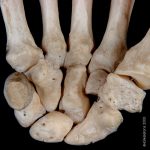The eight carpal bones are small, compact, irregularly shaped bones arranged in two rows. From lateral to medial, the proximal row consists of the scaphoid, lunate, triquetral, and pisiform. The distal row, from lateral to medial, includes the trapezium, trapezoid, capitate, and hamate. The trapezium, scaphoid, hamate, and pisiform each serve to anchor a fibrous band of tissue known as the flexor retinaculum. The retinaculum forms the carpal tunnel, through which the flexor muscles pass from the lower arm to act on the hand.
 Because each carpal bone has such a distinct shape, they are not easily confused with one another. However, as the shapes are extremely irregular, they can be difficult to master. Each carpal (except the pisiform in some cases) can be sided unambiguously by identifying the facets for other carpals and applying your knowledge of the anatomical relationships between the carpal bones. Even so, because of the complex articulations of these bones positional siding “tricks” can be especially useful for carpals.
Because each carpal bone has such a distinct shape, they are not easily confused with one another. However, as the shapes are extremely irregular, they can be difficult to master. Each carpal (except the pisiform in some cases) can be sided unambiguously by identifying the facets for other carpals and applying your knowledge of the anatomical relationships between the carpal bones. Even so, because of the complex articulations of these bones positional siding “tricks” can be especially useful for carpals.
Return to the metacarpals or manual phalanges.
Siding: Position the bone in proximal view, with the convex facet for the radius facing you, with the tubercule pointing up. The tubercule is on the side from which the bone comes.
Siding: Position the bone in a distal view, with the large crescent-shaped capitate facet facing you, with the triquetral facet pointing upwards. The triquetral facet is on the side from which the bone comes.
Siding: Position the bone such that the line where the lunate and hamate facets meet is vertical, and the pisiform facet is up. The pisiform facet will be on the side from which the bone comes.
Siding: The pisiform cannot always be accurately assigned to side, although the lateral surface usually bears a small grove for the ulnar artery.
Siding: Orient the bone such that the saddle-shaped articular surface for the first metacarpal is away from you and the laterally-positioned palmar ridge is up. This ridge will be on the side from which the bone comes.
Siding: Orient the “boot” with the “sole” down with the V-shaped junction of the second metacarpal and trapezium facets facing you. The boot will point to the side from which the bone comes.
Siding: Consider that the head of the capitate is proximal, and the dorsal surface is much broader and flatter than the ventral surface. The dorsal surface bears a large pointed process which points medially. If you position the bone so that the broad dorsal surface is down, and the base for the metacarpal articulations is facing you, the pointed process will be on the side from which the bone comes.
Siding: Position the bone such that the hamate is up, and the metacarpal articular surfaces are away from you. The hook of the hamate leans towards the side from which the bone is from.